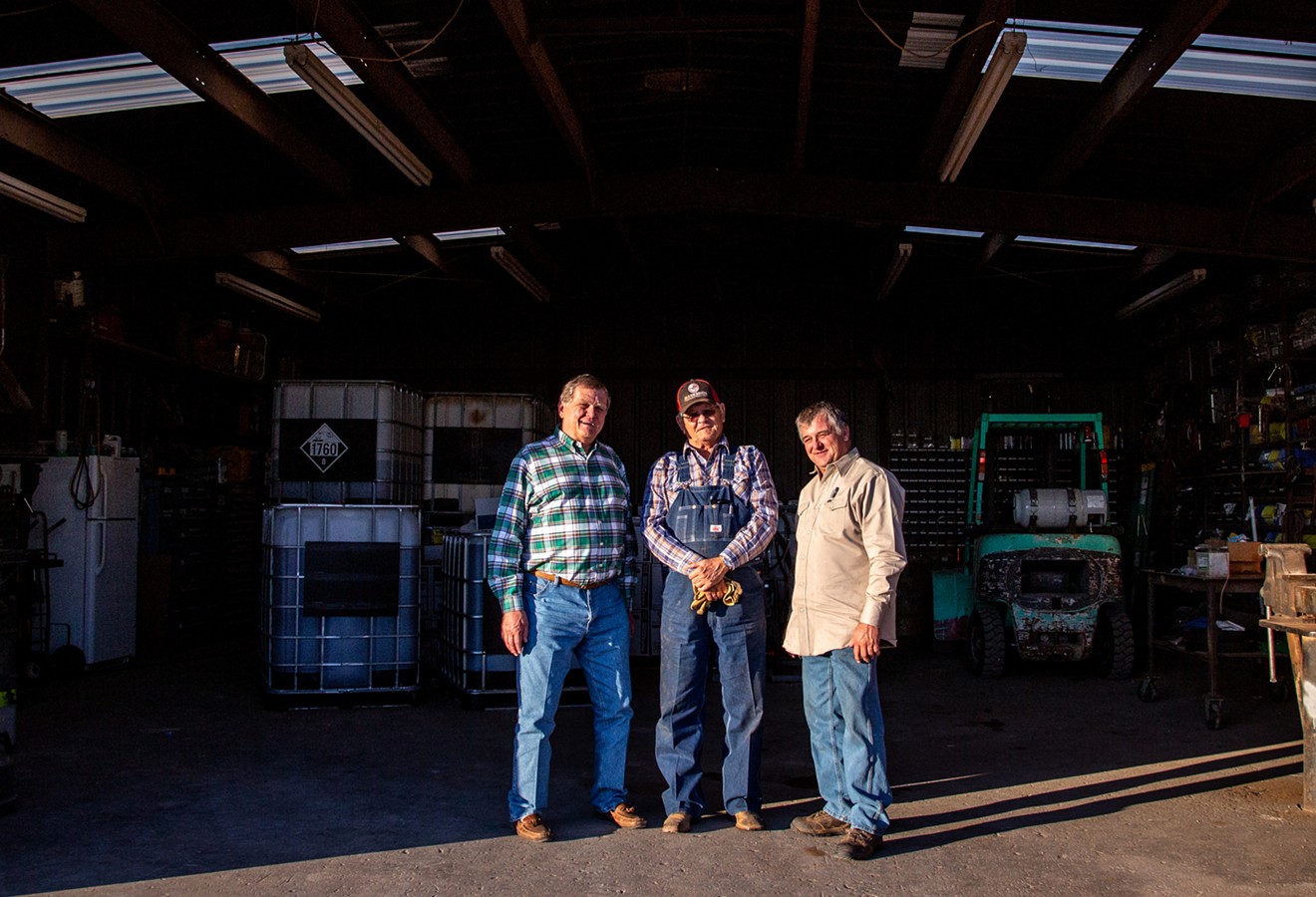McAlister, a third-generation farmer outside Wichita Falls, is in his mid 50s, clean shaven with gray-tinged black hair. He shows little emotion as he describes in his Texas drawl how he destroyed the crop he nurtured through summer. This is just the way it goes sometimes. He has other crops, and the insurance money will cover enough to keep the farm going for another year. He’ll pay some bills and try again next year.
McAlister’s family has watched bumper crops sell like gangbusters and devastating conditions destroy entire years’ profit. One particularly dry year, a spark from a passing vehicle burnt up their entire wheat crop along with the neighbor’s fields in 45 minutes; drought and bugs regularly eat away at the healthy crops; freezes and hailstorms can wipe out an entire crop.
“You lay in bed at night thinking, ‘How am I gonna pay that bill?’ And you lay in bed the next night thinking, ‘How am I gonna pay that bill?’” McAlister says.
Low prices, high operation costs, an aging generation and stacks of bank bills weigh on farmers. Farmers and agriculture officials say many Texas growers selling crops break even or fall just short.
“I farmed 650 acres until 1991, and I made a living on that. And I’m farming 2,700 today, and I can’t make a living on it." — Kenneth McAlister
tweet this
Nationwide, wheat and corn sell for roughly the same as they did in 1970. Macro Trends, a nonpartisan market reporting service, says a bushel of wheat sells for about $5 today, about the same as it did in the early ’70s. The same is true of corn, which averages $4 per bushel today. (Neither figure accounts for inflation, and today’s $5 buys much less than it did in the ’70s. Though prices vary widely year to year, the historical trend is down.) Half of all U.S. dairy farms closed in the last 30 years, and half of those in the past 10, according to the American Farm Bureau.
The Farm Bureau reported that, nationwide, farm bankruptcies rose by 24% last year; in Texas they were 15% higher than in 2018.
Sometimes, hard times on the farm take a toll beyond finances. National health agencies estimate that the suicide rate among farm owners and workers is as much as three to five times higher than the national average. While Texas’ farmers aren’t the hardest hit in the nation, they are far from immune to the effects of stress and often reluctant to seek help. Many Texas counties also lack sufficient mental health resources.
Hard Way to Earn a Living
Tucked up at a plain wood table for lunch at a roadside BBQ joint outside Wichita Falls, McAlister talks cotton, farming and the commodities market with his neighbor Barry Mahler.
“When I was a kid growing up, I have to say I enjoyed it. I loved it. And I’ve enjoyed it up until the last few years. And I still enjoy it, but it’s just stressful,” McAlister says.
“But it’s hard on you, Ken, look at that gray hair,” Mahler says.
Mahler, a Wichita County commissioner and third-generation farmer, says he’s seen this kind of downturn a couple of times before and is thankful for his commissioner’s salary.
Healthy cotton yields three or four bales per acre, and McAlister says he has to make a bale and a half to two bales per acre for a crop to be worth harvesting. This year, he guesses his fields would have produced about a quarter bale per acre.
McAlister and Mahler dry farm, which means they’re completely dependent on rainfall.
“You gotta have Mother Nature to help you. So you think you got everything figured out and Mother Nature comes along and tampered with you, you’re in trouble,” McAlister says.
This year, his cotton plants’ long taproots spent a dry, hot summer pushing ever deeper into the soil seeking water they never reached. McAlister pinpoints the day he lost his cotton: Aug. 15. Usually, mid-August rain spurs the crops into their final growth before harvest. The rain didn’t come last year, and by Sept. 1, he was pretty sure the crop was done.

Kenneth McAlister demonstrates how the taproot on a cotton plant digs down into the earth in search of water.
Meredith Lawrence
“I farmed 650 acres until 1991, and I made a living on that. And I’m farming 2,700 today, and I can’t make a living on it,” McAlister says.
Mahler grabs a paper napkin from the table and borrows a pen from McAlister. Consulting with McAlister, he writes out the cost per acre for land, seed, preparation, planting, fertilizer, herbicide, growth treatment and harvest. If a farmer’s lucky, that’s $261 an acre. A bale of cotton sells for about $312.
McAlister fell $225,000 short of what he was expecting to make on this year’s crop. That’s the difference between paying all the bills and having to refinance the house. He’ll have to limp along on the insurance money and income from other crops. But still, one good cotton harvest next year would make it all up.
McAlister and Mahler estimate that since the 1960s, what farmers get paid hasn’t changed much. But the cost of seed, harvest, storage and equipment has crept up.
In 1985, McAlister sold his first wheat crop for $4.85 a bushel, which is enough to make around 90 loaves of bread, according to the National Festival of Breads, a Kansas-based wheat farmer resource. Fertilizer cost $120 per ton in 1985, or $288.51, adjusted for inflation. Today, fertilizer runs McAlister $430 per ton and this year his wheat sold for $4.75 a bushel.
A loaf of bread cost around 74 cents in 1985. It’s about $2.35 today.
“It’s the only industry where we’re selling everything wholesale and we’re buying everything retail,” McAlister says.
John Wayne Types
Mahler worries about the mental health of his friends and neighbors who don’t have the sort of added income his commissioners job provides him. Many of them experienced serious financial strain in the last few years, sometimes struggling to scrape together the next bill payment. And while money problems often contribute to deteriorating mental health, Mahler believes most of the guys he knows wouldn’t be likely to seek treatment.
“We find some kind of John Wayne types in rural Texas,” he says. “These guys are not the ones that will go to the coffee shop in the morning and sit around and talk about how depressed they might be or what a real mental stress this is.”
Farming is physically strenuous, but because so much of their business relies on factors beyond farmers’ control, it’s also an extremely mentally stressful job. Farmers have no way to control the weather or commodity markets and often live fairly isolated lives, which sets them up to feel helpless and out of control more frequently than most Americans, says Erica Nason, a social work professor at Texas State University in San Marcos, who studies mental health in rural populations.
A robust network of mental health facilities used to cover rural Texas, but funding cuts have led many to close in recent years. Wichita Falls has a therapy center and mental hospital, but there are a lot fewer options for treatment than there used to be, Mahler says, even in the relatively populous Wichita County. Elsewhere in Texas, there are even fewer options. Nason says there are 183 counties in Texas that have no mental health facilities at all.“The only thing that keeps us going is a hopeful next year.” — Scott Savage
tweet this
After she saw a 2016 Centers for Disease Control and Prevention report that showed farmer suicide rates are five times higher than the national average, Nason sought out existing research and found very little. She applied for, and received, a grant to fund research into the causes of farmer stress and suicide and this year started a pilot program that gives agriculture students basic mental health skills. The idea is that the students, most of whom live and work in rural communities, are positioned uniquely well to see mental health problems and more likely to be trusted by farmers.
The CDC eventually retracted its report, citing coding errors for several of the occupational groups it evaluated. But the data in a replacement report still indicates that farmer suicide rates are among the highest in the nation. In response to the CDC’s report, the National Farmers Union said that the data clearly shows a serious need for help for farmers and further study of the issue. A 2018 report from the National Center for Biotechnology Information examining suicide in agricultural communities indicates that farm owners and workers are between three and five times as likely to kill themselves as the general American population.
Over the past couple of years, news outlets produced a steady trickle of stories about farmers who just couldn’t take it anymore. Last year, The Washington Postpublished a story about a widow afraid she will lose everything after her husband shot himself last June; The New York Times recently wrote about a farmer in the Catskills who, after seven generations, has chosen to sell his family farm because it’s the only way he sees to survive; and The Kansas City Star wrote about a new website run by the state of Kansas aimed at cutting down on the state’s high farmer suicide rate.
While the economic struggles in Texas haven’t reached the point they are at for many farmers in other states, that doesn’t mean they won’t, Mahler says. McAlister farms down the road from him and together they map out the agriculture operations that used to dot the region. In the 1970s, they knew about 50 farmers in the area; today that number is at most 12. Farming can be a grueling, draining way to make a living. Fewer children take over the family business than they did a generation ago. Today’s startup and equipment costs make it virtually impossible to start a farm from scratch.
Mahler and McAlister both have children who work with them on their farms at least part time, but they know neighbors, third- and fourth-generation farmers, with no children willing or able to take over. What happens to the industry if no one wants to pick up where the last generation left off?

Scattered cotton stalks and bolls from this year’s failed crop will still insulate the earth.
Meredith Lawrence
Risky Business
A few years ago, McAlister and Mahler both switched primarily to no-till operations. Not plowing fields lets natural nutrients and cover crop roots build the soil into a dense and healthy environment that retains rainwater. Although they use herbicides and fertilizer, much less of those products end up in the water system because most of it stays on their land now.
Instead of planting crops in neatly tilled rows, McAlister now plants cover crops year-round that increase soil health and act as insulation to keep soil cool in the summer and warm in the winter. He also spends less on plowing, fertilizer and herbicides because more of it stays put.
For years, he says, a farmer was judged by how neat his crop rows were and how clean the ground on either side was. Now, McAlister proudly points out the roughage left on the ground between his rows of cotton and can rattle off the different cover crops he uses.
Driving across one of his fields, McAlister’s truck tires crunch on dry stalks left to insulate the ground. When they decompose, they will feed nutrients back into the soil.
No-till operations helped reduce expenses, but all that effort doesn’t mean a thing if the rain doesn’t fall.
And it’s not just the weather that’s unpredictable. At lunch, neighbors and friends stop by the table — a fireman, an insurance adjuster, fellow farmers. Each time one leaves to carry on with his day, McAlister and Mahler tell them to be careful.
Be careful, they say in return.
The Bureau of Labor Statistics estimates that farmers, ranchers and agricultural workers have the seventh-highest workplace fatality rate in the American workforce.
Driving in McAlister’s white Ford truck past mostly barren fields, oil wells and stands of dry mesquite, they rattle off incidents. McAlister’s grandfather was hit and killed by a train as he rounded up his cattle. A McAlister farmhand died after he blacked out, hit his head and rolled off the back of the tractor he was driving. He ended up getting caught in the machinery. A neighbor had a heart attack while riding a tractor and got into an accident, and no one knows whether the accident or heart attack killed him. One of McAlister’s sons died 18 years ago in a riding lawn mower accident.
Still, family connection motivates both men and every other farmer interviewed for this story to keep going. One even described it as a craving to work the land. They love what they do and can’t imagine another way of life or leaving the wide-open country they farm. Even at the end of a long, grueling day, there are grandchildren to play with and no stifling, recycled office air to breathe on the daily 9-to-5 grind.
“It’s not a business to me. It’s a family way of life,” McAlister says. “We can all come together at the harvest.”
And so, every time they say goodbye, he says, “Be careful.”

Kenneth McAlister and Barry Mahler inspect some of McAlister’s cotton crop. McAlister’s cotton plants didn’t produce enough to be financially worth harvesting and selling this year.
Meredith Lawrence
High Tech, High Prices
Equipment and farming advances have increased production and cut down on the need for hired help, but the new technology and equipment have raised the cost of farming exponentially.
When McAlister and Mahler started farming, the operations were a lot simpler, but the yield was lower, too. Technology advancements push farmers into the more expensive, higher-yield future.
Going back to that way of life would be cheaper, certainly, if they could find the functioning lower-tech equipment. Highly digital new farm equipment gives farmers tracking and precision capabilities they didn’t have decades ago. But new farming regulations and the complex abilities of these machines mandate detailed, time-consuming paperwork about everything that happens on the farm.
McAlister and Mahler chew over the question of going back, circling back to it repeatedly. It’s a Catch-22 of sorts. If they could track down functioning low-tech equipment, it would certainly be cheaper to own and repair than the hyper-advanced equipment they use today. But those tractors and combines require more workers to operate, whereas today’s farm machines are primarily run by one person. Farm help is harder to find than it used to be, they say. The seeds they use now have been engineered to be hardier and produce more cotton.
They could spend less on operating costs, but they’d also produce less cotton. More important though, the money saved wouldn’t begin to make up the increased cost of living, and they’d be selling less. And so, they do their best to keep up with the newest technology trends.
“You acquire things,” Mahler says.
“A lot of debt,” jokes Larry McAlister, Kenneth’s father.
All three laugh. Farming is hard right now, but they still find a way to joke about the hardships, McAlister says.

Kenneth McAlister points out where more cotton bolls would have grown if the plant had had more water this year.
Meredith Lawrence
Scott Savage, who grows organic Texmati long-grain rice along the Texas Gulf Coast, says equipment prices mean starting a farm from scratch is beyond the reach of most farmers. Since 2009, he has worked with his grandfather, father and uncle in the family rice business.
“I couldn’t imagine trying to get an operating loan starting out with current markets/inputs,” Savage wrote in an email. “Having a family business with history is what it takes to hopefully survive, currently.”
While McAlister suffered from too little rain, Savage faced the opposite problem. Hurricanes, periods of unusually wet weather and low market prices made the past three years tough, he says. Rice requires regular water, so even with lots of rainfall, he still needed to irrigate because the rain didn’t always fall when his crops needed it. Each year for the past four, water prices went up, rising from 15% of his annual budget to 33%. The rice sells for roughly the same each year, but fertilizer, chemical and equipment prices creep up.
“The only thing that keeps us going is a hopeful next year,” Savage says.
Starting Small
Just outside of Dallas, Aaron Reeves, a first-generation farmer, got around prohibitive startup costs by starting really small and choosing a crop he could harvest by hand or hire workers to help pick. Hope for next year is what he focuses on, too.
Growing up, he spent hours in his great grandfather’s garden and loved it. He dreamed of opening a farm. During the 1990s, he watched family-run okra farms, once a staple crop in North Texas, disappear.
In 2006, Reeves leased 8 acres and planted okra and a few cantaloupe plants. He grew just enough in that first year to sell to a local okra farmer who’d lost some of his crop to drought. Little by little, he increased his operation, often going himself to knock on the back door of grocery stores to sell his produce.
Last year, Reeves planted 40 acres of okra, but he only harvested 30 of them because he couldn’t find the farm labor to help with it all. Fluctuating weather, a dearth of farm workers partly attributable to stricter immigration enforcement and pests have all cut into harvest and production in the last few years.
As production costs rise and market prices stagnate, land development and urban expansion threaten the land where food grew for generations and push farmers further afield to undeveloped land.
Ben Scholz grows wheat, corn and hay in Collin County. He grew up in the 1960s on a farm outside Wylie, but the creep of urban development eventually made continuing his father’s operation on the land where he was raised impossible. When a police dispatcher called in the middle of the night to tell him that his cattle were waiting at a red light in town, he realized it was time to move. Today, there’s a shopping center on the land where his parents farmed, and his grandparents’ old home is gone, replaced by a high school and a commercial and residential development.
Scholz now owns and leases land 20 and 30 miles east of Wylie, near Lavon.
Since 1945, the number of farms in the United States has dwindled by 2 million, according to the U.S. Census Bureau. Today, the U.S. Department of Agriculture estimates there are 900 million acres of farmland in the country. But the amount of United States farmland held by foreign investors has nearly doubled over the last decade, reaching 30 million acres last year, according to a report by the National Young Farmers Coalition. As aging farmers grow too old to continue to care for their land, some of them will have to sell, increasing opportunities for more foreign investors to purchase acreage. NPR reported that the coalition expects about two-thirds of farmland to change ownership in the next few decades.
Looking around the farming community where he grew up and now farms, Mahler can’t imagine losing the land his parents bought and worked hard to keep. His sons will inherit the land he purchased across the road from his parents’ house.
“The land is important,” Mahler says.
A few tears spill into the wrinkles on his cheeks. His family’s legacy is at stake here.
“If every generation will buy [the place next door] at some point we’ll have something that’s worth something,” he says.

McAlister’s cotton plants didn’t produce enough to be financially worth harvesting and selling this year. He will instead depend on insurance money to make ends meet.
Meredith Lawrence
Raising Hope
In some parts of the country, members of America’s working class are literally dying of despair, according to Tightrope, a new book by Nicholas D. Kristof, a New York Times op-ed columnist, and wife Sheryl WuDunn. Kristof, a human rights advocate, and WuDunn, a former Times foreign correspondent, chronicle how the residents of a rural community in Kristof's native Oregon and other communities across the country turn to drugs, alcohol, suicide and crime to deal with unemployment and unpaid bills. Many times, they die from health problems, accidents, self-harm and overdoses.
A shockingly low minimum wage that’s tragically out of sync with inflation, fewer job prospects, rising cost of living, isolation, drug addiction and economic disparity have hit rural and working class America hard — even those who are proud to grow the crops that feed and clothe us.
Where’s the breaking point?
McAlister and Mahler won’t say — for them the situation hasn’t gotten bad enough yet. They’re filled with hope for the new year, talking animatedly about how a new deal enabling farmers to grow hemp might boost their sales and also be a strong cover crop. Hemp is hardy and sprouts deep roots that will keep nutrients in the soil and leaves fibrous straw that will protect the ground long after harvest.
They’re talking about growing cotton differently, too. If they only plant only two rows out of every three, the plants will have more room to bulk up and be more efficient at sharing what little water there is if there is another drought next year.
McAlister and Mahler are still optimistic but, above all, careful. Saying goodbye, the refrain from earlier in the day comes back. You never know what might happen out here, so be careful.












